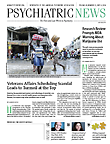Insight into a patient’s cultural background is not the only key to diagnosis and treatment, but it often can play an important role in both, said Ramaswamy Viswanathan, M.D., D.M.Sc., director of the psychiatric consultation-liaison service at the State University of New York Downstate Medical Center in Brooklyn.
“There are more similarities than differences across cultures in the nature of psychopathology and core treatment principles, but cultural issues can influence the mode of symptom presentation, treatment seeking, stigma, clinician-patient relationships, and optimal treatment techniques,” said Viswanathan in an interview with Psychiatric News.
He and others recently spoke at a conference on the mental health of Asian-Indian Americans in New York. The program was organized by APA’s Division of Diversity and Health Equity in collaboration with the Indo-American Psychiatric Association and the American Association of Physicians of Indian Origin—Queens and Long Island. About 100 people attended the conference, a mixture of psychiatrists, psychologists, and social workers of Indian origin.
Traditional Indian cultural values tend to prize subjugation of self to the family, family honor, shame, social approval, and obedience to authority, said Viswanathan, who is chair of the Board of Trustees of the Indo-American Psychiatric Association. At the same time, other aspects of Indian culture—such as the practice of yoga, breath control, and meditation—may influence cognitive-behavioral therapy approaches.
Karma—accepting what happens as God’s gift—may provide comfort in some cases, he explained. There was a lower-than-expected level of posttraumatic stress disorder in south India following the deadly 2004 tsunami, for example. However, that same acceptance may also lead to passivity and an unwillingness to act to change one’s life.
There is a tendency to somaticize symptoms, he noted, citing a case in which a young woman who had immigrated as a child to the United States from South Asia with her parents developed nonepileptic pseudoseizures. The consulting psychiatrist believed that the pseudoseizures might be the somatic expression of her anger at her marital problems and referred the patient to a female psychiatry resident from the same country of origin and with the same religion and language. That therapeutic connection, in turn, began a process that led to resolution of the patient’s problems.
Children of immigrants may vary in their risk for mental illness, depending on the circumstances in which they grew up, he pointed out.
“A Dutch study found that those who live in ethnically dense neighborhoods with many other members of the same group show a lower risk for psychosis compared with those who live in less-dense neighborhoods,” he said. “The children of Indian immigrants also face the task of balancing two different cultures as they grow up in the U.S.”
Patient-therapist language or ethnic-matching may promote treatment adherence both in psychotherapy and pharmacotherapy, said Viswanathan. “However, as there are variations among individuals from the same culture, one should guard against cultural stereotyping while still paying attention to cultural influences affecting the individual.”
Studies have shown that Asian Americans in general tend to delay seeking mental health help, seek it only for severe disorders, and underutilize mental health services, he said.
“It is important not to lump diverse populations into one category,” agreed Annelle Primm, M.D., M.P.H., APA deputy medical director and director of APA’s Division of Diversity and Health Equity. “The term ‘Asian-American’ covers a lot of geographic and cultural territory. There’s a lot of heterogeneity, and it’s important not to lose the details of a specific culture.”
A genuine interest in and respect for the individual patient and the cultural context can help find points of commonality and bridge initial cultural barriers, Viswanathan emphasized. ■
Information about the Indo-American Psychiatric Association can be accessed
here.
